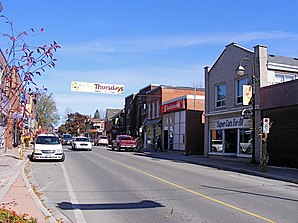Acton (Ontario)
| Acton | ||
|---|---|---|
 Downtown partial view |
||
| Location in Ontario | ||
|
|
||
| State : |
|
|
| Province : | Ontario | |
| Regional Municipality : | Halton | |
| Coordinates : | 43 ° 38 ′ N , 80 ° 2 ′ W | |
| Residents : | 9704 (as of 2011) | |
| Time zone : | Eastern Time ( UTC − 5 ) | |
| Foundation : | 1828 | |
Acton is located in central southern Ontario on Black Creek , a tributary of the Credit River . It was established as a city on July 1, 1950. From January 1, 1974, it became a district of Halton Hills and part of the Regional Municipality of Halton . The number of inhabitants in 2001 was 7,767 people. Acton is located on Ontario Provincial Highway 7 between Brampton and Guelph , Ontario, and is regularly served by the GO Transit Bus Service on the Georgetown (Go Transit) line.
Leather city
The city is popularly known as the leather city as it has an intensive leather processing industry that flourished between the 19th and 20th centuries. During this time, Acton was the largest community in the Halton Hills region, much larger than nearby Georgetown, which today has more than twice the population. The Acton area was particularly suitable for the leather industry because of the large amount of trees that could be found in the area.
The moniker is now only used by the Olde Hide House, a large leather goods dealer in an old warehouse, and Beardmore Leather in the old town. The city also has Fairy Lake, a man-made lake that is out of reach of many of Acton's locations, and Prospekt Park.
Geographical location
The hydropower of Black Creek was instrumental in determining the location of the town and the mill that has been in operation there to this day, although fundamental things have changed. Acton is located near the watershed between the Credit River and the Grand River , which is west of the local area where the Blue Springs Creek rises.
population
The city was briefly portrayed as a "truly white community" in June 2005, according to CBC Radio . Acton was largely Protestant until the Halton Regional Consolidation Act was completed in 1974. He declared the entire Halton region as a separate school zone, which contributed to the uniqueness of the city, as it was the only local community that did not have a Roman Catholic school.
The mix of the population changed in the 1990s when new developments took hold, after water and economic restrictions subsided after they had existed for about 30 years. New development areas in the north and east of the city are expected to increase the population by up to 10,000 people.
Name of the inhabitants
It is significant that in older books and papers describing this region there are not one but two names for the inhabitants of Acton. The name "Actonite" was used to distinguish people who moved to Acton from the native inhabitants of the Actonians who lived there since childhood. The first name was used more and more as more and more people moved from the outside to Acton in the 1960s, but the old residents still mention this name occasionally.
Personalities of Acton
swell
- Acton's Early Days (1939); privately published by The Acton Free Press, last reprint 1978
Web links
- City map (PDF; 493 kB)
- Acton Business Improvement Area
- The Olde Hide House
- Current Weather Conditions in Acton
- Halton Hills Chamber of Commerce Serving Halton Hills (Acton, Georgetown and surrounding area)
